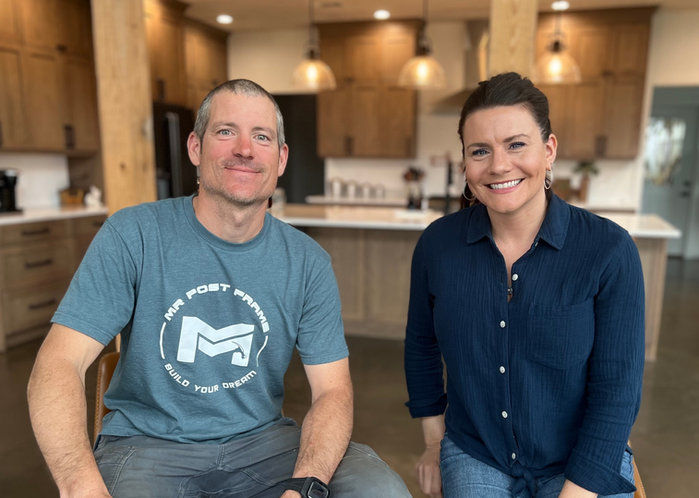Wood Stove Accessories + Setup + Chimney Install
- MR Post Frame
- Jun 17, 2024
- 4 min read
Welcome back to MR Post Frame! Today, we're diving into the installation process for a Regency F5200 wood stove. I've received numerous questions regarding topics like the need for makeup air, the stove's efficiency, why I opted for a wood stove over an insert or conventional fireplace, among others. But before we get into those questions, let's discuss the installation process in detail.

First off, it's crucial to consult the manual provided with any wood stove purchase. These manuals typically include essential information regarding clearances for residential and mobile home installations, complete with diagrams and specifications.
Examining the stove itself, we find that the clearance from the back of the stove to the wall (designated as "B") measures at 10 inches. In my setup, I've positioned the stove approximately 16 inches from the wall, ensuring ample clearance. Additionally, considering the height of the installation, which spans 18 feet to the ceiling, I opted for double-wall piping for added rigidity.

So far, we've covered various aspects of our stove, from installing a hearth to setting up the wood stove, chimney, and even crafting and installing a live-edge mantel. If you're keen on any of that, check out the wood stove playlist on YouTube. Now, let's dive into the installation process of these accessories.
Adhering to the recommended standoff distances is crucial for safety. Despite the low likelihood of a fire hazard if the instructions are followed diligently, it's always best to error on the side of caution. Moreover, local regulations may impose additional requirements, so it's wise to verify compliance with local authorities.

Having situated the stove correctly within the specified clearances, I've taken additional precautions. With a concrete floor, a non-combustible Versetta Stone wall, and a wooden shiplap ceiling, I've ensured a safe environment for the stove.
Moving on to the installation process, marking the ceiling for the stovepipe requires precision. While a plumb bob is an option, I prefer using a laser level for accuracy. Once marked, cutting the hole becomes straightforward.
First up, we've got all the fire bricks installed, and we've decided to incorporate an ash drawer. Instead of placing the last fire brick, we've made room for the ash drawer cover. It's a simple setup where the cover sits in place and can be conveniently lifted out with a tool when needed. This ash drawer provides ample space and comes with a handle for easy maneuvering.

In the attic, where the pipe extends through the ceiling, bracing and support are essential. I've constructed a framework to ensure stability and proper attachment points for the transition piece. We’ve installed a blower, it was a straightforward process involving just two screws. This blower can be operated either manually or through a built-in thermostat, ensuring efficient use of electricity. Additionally, we have a heat deflector to redirect the heat forward, complementing the blower's function in circulating warmth throughout the space.
The transition from the ceiling to the roof is a critical step. Accounting for the roof pitch and material, I've designed a heat shield to maintain the required standoff from combustibles. This shield, along with proper sealing and flashing, guarantees a secure roof penetration.
Next in line are the thermostats. The first one is a catalyst thermometer crucial for the stove's triple burn technology. It monitors the stove's temperature, ensuring optimal functionality. The second thermostat, installed in the double-wall chimney pipe, provides insights into the stove's performance and temperature regulation.
Completing the installation indoors involves assembling the stovepipe components meticulously. Following the manufacturer's instructions, each section is secured with screws, ensuring a tight fit and proper airflow. A vital aspect to remember is to remove the flu thermometer before cleaning the flue to avoid damage. This wood stove also features a bypass for controlling airflow, providing flexibility in heating operations.

Outside, on the roof, attention to detail is paramount. The pipe must extend a sufficient distance above the roofline, considering local regulations and weather conditions. Proper flashing and sealing techniques are employed to prevent leaks and ensure long-term durability.
Now, let's address the frequently asked question: why a wood stove over other heating options? For me, living in an area with occasional power outages, a wood stove offers reliable heating without dependency on electricity. It's a sustainable choice, utilizing wood from our property for fuel, and it's remarkably efficient, offering 360-degree heating capabilities.
Regarding the stove's drawing capabilities, the smoother the chimney run, the better the draw. Despite any bends in the pipe, the stove functions effectively, albeit with some initial adjustments during lighting.
In conclusion, meticulous planning and adherence to safety standards are essential throughout the installation process. Regular maintenance and inspection further ensure the stove's safe and efficient operation.
Thank you,
MR Post Frame

Patreon Group:
Interested in tackling your build on your own? If you want to explore the possibility of being your GC or self-building, our Patreon membership is for you! It's a community of like-minded people offering support, discounts, Q/A, and more.